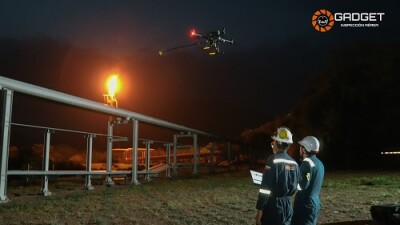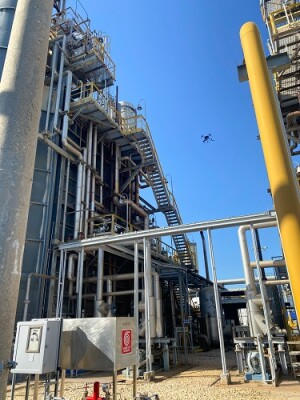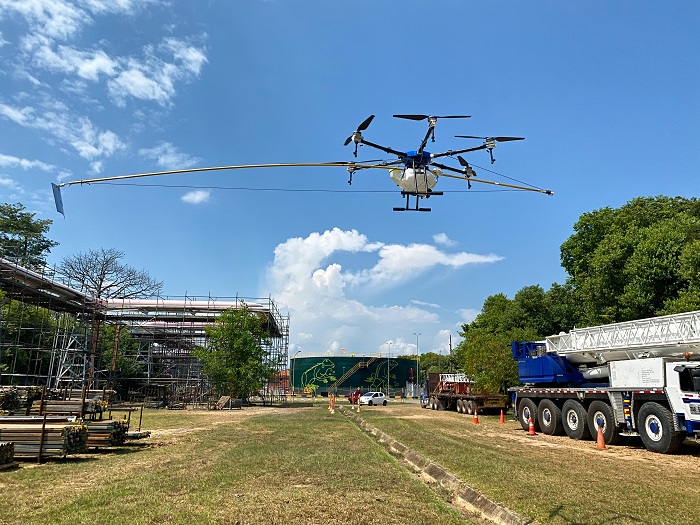Drones are amazing at removing humans from dangerous tasks, and very few activities are more potentially dangerous than handling highly combustible elements such as petroleum products.
Since the inception of the first uncrewed aerial vehicles (UAVs), the oil and gas industry saw an opportunity to convert certain workflows that involved men and women in dangerous areas and replace them with aerial and ground robots that would collect data and broadcast for remote analysis.
Even though there are probably thousands of success stories associated with the deployment of UAVs in oil and gas, saving a refinery from a major disaster should rank pretty high up.
 Gadget Drone Services S.A.S. (Gadget Drone) in Colombia was created by a group of aeronautical engineers precisely with the goal of providing the thriving energy sector in that country with a safe and reliable alternative to perform non-destructive inspections. We had the opportunity to interview Gadget Drone’s John A. Quevedo, Commercial Manager, Roberto Copete, Technical Director, and Monica Zambrano, General Manager, who explained how the company was conceived and how the market needs shaped it to its present form.
Gadget Drone Services S.A.S. (Gadget Drone) in Colombia was created by a group of aeronautical engineers precisely with the goal of providing the thriving energy sector in that country with a safe and reliable alternative to perform non-destructive inspections. We had the opportunity to interview Gadget Drone’s John A. Quevedo, Commercial Manager, Roberto Copete, Technical Director, and Monica Zambrano, General Manager, who explained how the company was conceived and how the market needs shaped it to its present form.
“It all started in 2020 with the beginning of the pandemic and the fact that we all lost our jobs in the aviation sector to massive layoffs and the collapse of air travel,” explained Zambrano. “Since 2019, Roberto, John, and I had been toying with the idea to launch an uncrewed aviation enterprise but didn’t have the incentive or the motivation to leave our lucrative jobs in pursuit of a dream. That all changed at the beginning of 2020 with COVID, and we found ourselves forced to be creative and to improvise, so we founded Gadget Drone and initially targeted the lucrative oil and gas industry.”
Even though Colombia is known as a major producer of agricultural products, such as coffee, the South American country also produces abundant mineral resources, such as copper, emeralds, and a considerable amount of oil in the areas adjacent to the plentiful Venezuelan western fields of the Maracaibo Lake.
“There was a huge need for services that could be performed without too many personnel and the same issues that were affecting the aviation industry. Illness and absenteeism was having an impact on oil exploration activities and oil refineries, so we took the risk and bought our first drone and equipped it with sensors that would help demonstrate the capabilities of performing aerial non-destructive inspections, without involving too many humans,” said Quevedo.
Colombia is at the forefront of the uncrewed aviation industry in Latin America, but most companies are involved in conventional mapping, aerial video and photography, and lots of agricultural applications, but Gadget Drone’s idea to penetrate the oil and gas industry was uncontested and had very little or no competition at the time.
“Our big break came while inspecting a 300-foot tall flare used to alleviate the resulting gas from the refinery processes. At 236 feet, the drone, using a thermography sensor discovered a hole that was three inches wide and was sucking air into the metal tube and threatened the entire structure and potentially the refinery too,” Copete said. “An emergency situation emerged as the oil engineers and managers of the plant decided that the hole had to be sealed immediately.”
Because the flare was contained inside a supporting tower, the actual tube with the hole was 13 feet inside the intricate maze of beams that formed the outside structure. Between refinery management and the Gadget Drone team, it was decided that the drone had to be modified to perform the fix. It was the fastest way to avoid certain disaster.
 “Imagine our surprise when we found ourselves outrigging our drone with a 26 foot pole, 13 feet on one side with the magnetic patch and 13 feet to the opposite side to maintain the center of gravity and allow the UAV to fly!” Copete continued. “We had a hard time maintaining a stable flight that would allow the engineers to see clearly where the hole was and how to apply the patch, so we had to remove the camera from the outrigged drone and use a second drone to monitor the operation. Both drones were controlled by our expert pilots, and, in a few hours and after many attempts, the magnetic patch successfully attached to the flare and disaster was averted. It took four days but after that we became a trusted service supplier of the plant management team.”
“Imagine our surprise when we found ourselves outrigging our drone with a 26 foot pole, 13 feet on one side with the magnetic patch and 13 feet to the opposite side to maintain the center of gravity and allow the UAV to fly!” Copete continued. “We had a hard time maintaining a stable flight that would allow the engineers to see clearly where the hole was and how to apply the patch, so we had to remove the camera from the outrigged drone and use a second drone to monitor the operation. Both drones were controlled by our expert pilots, and, in a few hours and after many attempts, the magnetic patch successfully attached to the flare and disaster was averted. It took four days but after that we became a trusted service supplier of the plant management team.”
This initial inspection and ensuing improvised repair opened the door for the engineers to ask for more services and to create an entire menu of non-destructive inspections that could be performed by the Gadget Drone team.
“We developed a series of processes to use ultrasound sensors mounted on a DJI Matrice 300 to determine the thickness of inaccessible structures without touching the surface,” Zambrano reflected. “That created a revenue stream that we were not expecting, and the company took off. Now, we are expanding into different areas of the industry and adding services and sensors to our offering.”
It does not matter how business is created; it is always the unexpected that brings success or failure to emerging enterprises. In this case, the team of pilots and engineers at Gadget Drone found a way to turn possible disaster into commercial accomplishment, and the result is another uncrewed aviation success story.















Comments